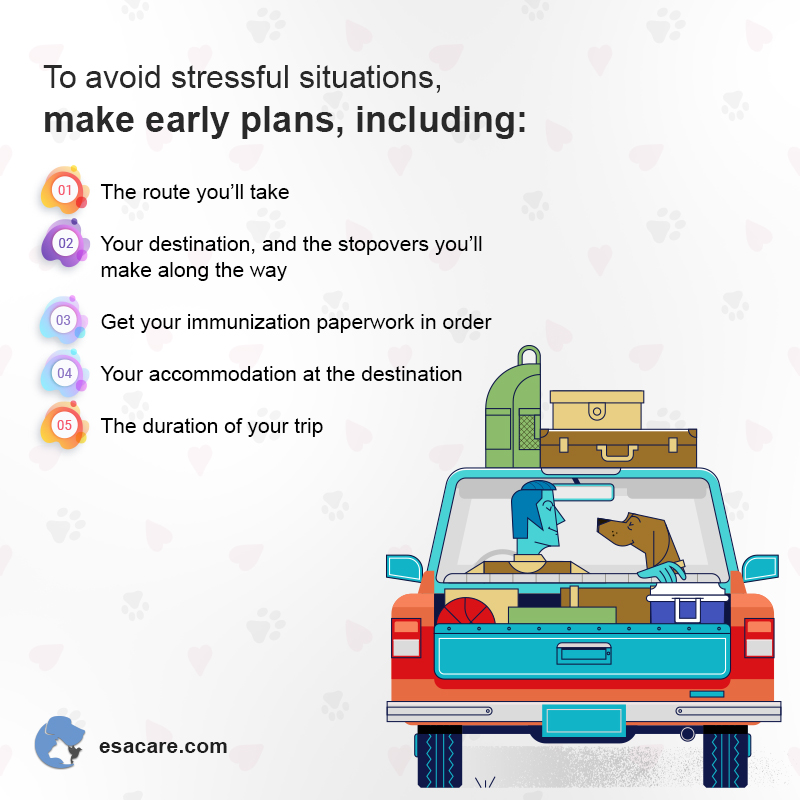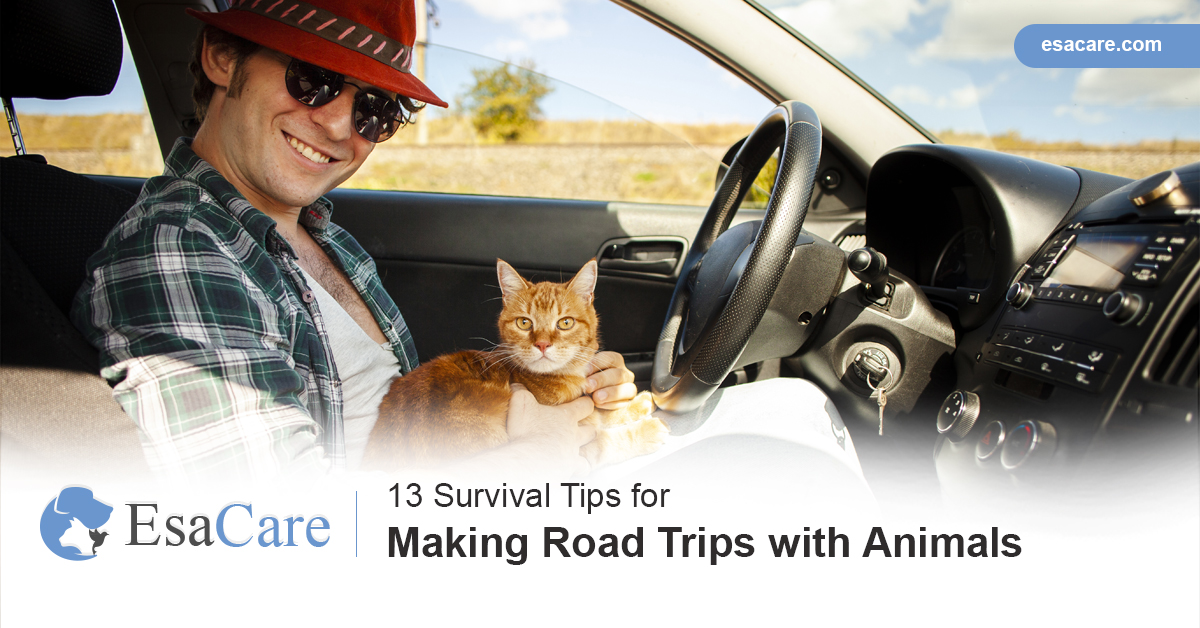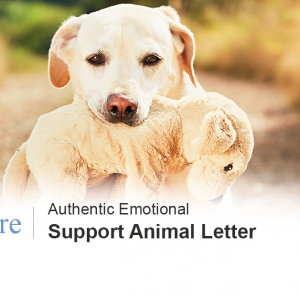13 Survival Tips for Making Road Trips with Animals
We all need regular breaks from the hustle and bustle of everyday life. Besides, everyone gets tired of following a strict schedule, thus doing something new and exciting. There’s no better way to rejuvenate than taking a road trip. A road trip can help you reenergize and break the monotony of everyday life. Something as simple as a short trip to a nearby city does a lot as refreshing your mind is concerned.
Travel with ease – get your ESA letter now!
If you’re a pet lover, you won’t find peace of mind if you take a trip without tagging your furry companion along. But this also raises a dilemma, what should you do to ensure that the pet stays happy, healthy, and safe making the trip? If you’re planning a trip with your pet, but you don’t know how to execute it, worry no more. We have 13 amazing tips that will help you to plan and execute the trip.
So, let’s get down on it!
Table of Contents
Tip Number One: Check Your Pet’s Fitness
Before embarking on a trip, it’s best to examine your pet to ascertain its fitness. Road trips can be quite long. One of the things that can ruin things is your pet being unwell. Worse still, the trip will be a forgettable one if you’re sick yourself.
Long road trips can get uncomfortable, more so if the pet isn’t feeling well. If you’re on an unfamiliar road, you won’t even know where to get a vet. When such a situation occurs, you won’t enjoy the trip, which is something you don’t wish to experience.
So, it’s better to get Teddy checked by a vet days before the trip. This way, he will get treated early, and you’ll be able to enjoy your road trip with him. If it’s discovered that the pet is unwell or has a health condition that isn’t showing any symptoms, you should reschedule the trip. A long and uncomfortable journey can exacerbate a mild condition. So, better get your furry companion treated first before planning the trip again.

Avoid stressful situations
Tip Number Two: Have a Microchip Installed In Your Pet
Pets tend to get excited when they are in a new environment. It’s common for them to wander off. Going on a road trip means going to a new place. As such, the risk of losing the pet will be high. Since you’ll be in a relatively unfamiliar place, it will be difficult for you to locate your pet when it wanders off. Getting the animal microchipped is the best thing to do when planning a trip. It will be easy to track the animal if it gets lost or stolen.
You’re probably cringing your face wondering how painful it is to install a microchip in an animal. Well, you shouldn’t get traumatized. Microchips are small, injectable pieces of technology that help you in many ways. Most importantly, a microchip will help you keep track of your furry companion throughout the trip. This way, you’ll have peace of mind and save the trip from becoming disastrous.
Besides microchipping your pet, note down your contact details on its collar. If you lose your furry companion in crowded places, or it wanders off, it will be easier for the owner (you) to be identified and contacted.
Improve your mental health by keeping your ESA pet close by – get your ESA letter today!
Tip Number Three: Plan Everything Early
Last-minute preparations can mess up your vacation. When planning a trip, it’s always advisable to plan everything, including the most trivial details. If you plan things at the last minute, chances are you’ll forget some important information. As such, you won’t know how to get around some things once you arrive at your destination.
Often, stress arises when you find yourself in a bothersome situation. This can tire you physically and mentally. Your pet will also bear the brunt of it. Regardless of where you’re planning to go, or whether the trip will be long or short, there’s a lot you can do to make it memorable and fantastic.
When planning the route you’ll take, it’s best to ensure that there are pet-friendly stopovers along the way. Better still, choose a route that has vet clinics along the way. This way, your pet will receive the attention it deserves in case it gets sick.
When traveling across state lines, you may be required to provide paperwork showing that your pet is vaccinated. Although this is not always the case, it’s better to be prepared for it. In this regard, take all the necessary vaccination paperwork and any other documentation that might be required by relevant agencies.
Obviously, you can’t go on a trip without knowing where you’re headed to. This highlights the significance of planning your destination. Also, decide how long your trip will take so that you pack enough essential supplies to last until you get back home. When choosing accommodation at the destination, find a pet-friendly place.
Book an Appointment by clicking the banner below.
Tip Number Four: Make Your Car Ready
One of the worst things that can happen during a road trip is mechanical failure. When planning a short or long trip, get your vehicle serviced early. Besides, it should be made comfortable for your furry travel companion. To prepare your vehicle for a road trip, here’s what you should do:
- Change the engine oil
- Change the radiator fluid and coolant, more so if you’re planning a long trip
- Change the brake fluid
- Change the transmission fluid
- Change the tires
- Change the power steering fluid
- Rearrange the seats
At this point, you’re probably wondering why it’s important to alter the vehicle’s seating arrangement. Well, if you’re going on a short trip, this isn’t that important. However, long road trips can get uncomfortable, thus the need to ensure your furry companion has as much space as possible. For instance, you can do away with the back seat if you intend to travel with pets such as dogs. This will allow you to put it in a more spacious carrier cage, thus ensuring its safety and comfort during the trip.
Tip Number Five: Travel with Essentials
Road trips require a lot of packing and unpacking. Since you’ll be traveling with a pet, you’ll be forced to carry along lots of essentials, which means more fill. While at it, ensure you don’t leave any essentials behind. Create a checklist since this will help you pack what’s necessary. Pack a few more items that might be necessary since you can’t tell whether you’ll need them while on the road.
Another important reason why you should tag along the essentials is that you might not find them elsewhere. Finding the things that your pet is accustomed to while in a new place can be challenging.

Essential Items to Carry on a Trip
It’s common for unforeseen circumstances to occur while on a road trip. Preparing for such emergencies when planning the trip will help you avert disaster. For instance, carrying medicine for you and the pet will come in handy in case either of you falls sick in the middle of nowhere. Likewise, a spare tire will help you get back on the road without any delays if you experience a puncture or tire burst.
In the comments section below, let us know about other essentials that one should pack before embarking on a trip with a pet.
Tip Number Six: Don’t Leave a Pet Carrier Behind
A pet carrier is one thing you shouldn’t forget when planning your trip. It will guarantee the animal’s safety while on the road. Animals tend to get restless during journeys. You can stay behind the wheel for hours, but the same cannot be said of your travel companion. Having it in a carrier goes a long way in keeping it calm throughout the trip. A carrier keeps your pet comfortable as you travel. Similarly, it prevents you from getting distracted by the pet, especially when the pet is unrestrained.
In this regard, it’s best to keep in mind that since pets aren’t accustomed to closed spaces, it won’t be easy to make your furry buddy sleep or even stay in a carrier at first. But, with time, it will get used to it. To ensure that the animal stays comfortable and safe while kept in a carrier, train it early. This way, it will get used to sleeping or staying in a carrier.
Once you have your pet in a carrier, it will be easier for you to focus on the road without worrying about your buddy’s comfort. And, talking about comfort, do not forget to throw a couple of blankets into the carrier before you set off on your trip. Check out our blog post on ESA training to learn how you can train your pet to stay or sleep in a carrier.
Tip Number Seven: Take Regular Pit Stops
Long road trips can be energy-sapping both to you and your travel buddy. It’s a no-brainer that when taking long trips, you must make stops. Such layovers allow you to stretch, have some food, enable your pet, take washroom breaks, and exercise the pet.
Many people may disagree that being behind the wheel for hours on end can affect your mental well-being. It builds up your anxiety, which isn’t a good sign for you. Indeed, pit stops can make your journey longer, but it helps. Let’s take a look at why you need pit stops along the way:
-
You Get to Stretch Your Body
That’s right!
After staying behind the wheel for hours, your muscles can get worn out. Stretching for a couple of minutes will help invigorate the muscles. Besides, sitting in one position for a long time affects your blood circulation significantly. All you need to restore proper blood circulation is to stretch for a couple of minutes before getting back on the road.
-
Washroom Breaks
Both you and your pet animal need a toilet break. You may be able to hold onto your toilet, but the same cannot be said of your furry companion. Therefore, you should take a couple of pit stops so that your buddy does its business. In the weeks preceding the trip, train your pet to go to the toilet at specific intervals. This does the trick when traveling since you’ll be able to plan your washroom breaks.
An ESA pet can improve your lifestyle – Click the button below.
-
Grab Some Food
Another important reason to make regular pit stops is that they allow you to grab some food for yourself and the pet. Being on the road tires you out, and there’s no better way to re-energize than feeding yourself and your travel companion. Therefore, whenever you’re traveling with pets, schedule pit stops for grabbing some food.
-
Exercising The Pet
Animals can get fidgety, more so when traveling to new places. On the road, it’s difficult to keep them calm and in one place for too long. An easy way of preventing them from getting anxious is scheduling pit stops for exercising them. This way, they won’t get bored or start to whelp. Besides, letting your pet sit in the carrier for too long can lead to injury. Therefore, ensure that you take pit stops during your trip.
Tip Number Eight: Have Immense Patience
When dealing with animals, patience is key. On your trip, you might encounter stressful situations, such as car breakdown, running out of gas, not getting sufficient rest, and having flat tires. If you get stressed, your little travel buddy will also be affected.
For that reason, you should stay calm at all times and tackle all stressful situations calmly. You’re probably thinking about how that’s possible. Well, if you follow all the tips mentioned above, you’ll be able to stay calm and maintain your composure since you’ll have everything sorted out properly. Moreover, you’ll be at peace and stress-free during the trip if you get everything sorted early.

Travel with Pets
Tip Number Nine: Take a Long Walk
Before embarking on your trip, take your furry travel companion for a long walk. This helps in many ways, including:
- Getting the pet tired
- Ensures that the pet sleeps for most of the trip
- Ensures that the pet doesn’t suffer from travel anxiety
If your pet stays calm during the trip, you won’t get distracted. Walks are also a form of exercise. It stimulates endorphins, which are the hormones responsible for happiness. Therefore, long walks before the trip benefit both you and the pet.
Tip Number Ten: Take Short Drives
Short drives come in handy if you have some time before your trip or you’re taking the pet on a road trip for the first time. During the weeks preceding the trip, it’s recommended that you take a couple of short trips so that the animal gets accustomed to staying idle for long periods.
Animals, more so dogs, tend to be active. It’s difficult to make them stay calm during a long trip. However, you can train them to get used to it by taking short drives with them. Such trips will make your four-legged companion more comfortable and accustomed to sitting in a car for long periods. You could also play some soothing music. It soothes both humans and pets!
Tip Number Eleven: Carry Extra Supplies
When traveling with or without a pet, it’s always advisable to carry extra supplies. You might not know what will happen along the way, thus the need to prepare for any eventualities. Having essential supplies is awesome, but packing extra supplies is even better. Regardless of the type of trip you’re planning; emergencies can occur at any time. So, it’s best to be prepared for anything.
Although we’ve already mentioned the essential supplies that you might need, it doesn’t hurt to name a couple of extra items that you might need during the trip.

Couple of Extra Things to Carry on a Trip
Tip Number Twelve: Staying in a Hotel
You should always book a pet-friendly hotel since this will ensure a comfortable stay for you and your furry buddy. Once you identify and book such a hotel, there are a couple of things to keep in mind, including:
- Checking out restrictions and extra charges relating to staying with a pet
- How to ensure that the pet stays clean at all times
- Check out whether the hotel is suitable for the pet
- Book a room on the ground or lower floors since it will be easier to take late-night bathroom walks with the pet
- Ensure there’s a way of communicating with the hotel’s management, more so when emergencies occur
- Avoid leaving the pet alone in crowded areas of the hotel since it might get anxious and start barking (in the case of dogs)
Tip Number Thirteen: Staying at Airbnbs
Sometimes, it’s advisable to book accommodation at places that offer personal space. When compared to hotels, AirBnbs guarantee more privacy and personal space for you and your pet. Therefore, they can be an excellent choice for you. However, it’s best to keep in mind that staying at an Airbnb comes with greater responsibility. We’ve outlined some tips that can go a long way in making your stay at an Airbnb hassle-free, which includes:
- Ensuring that the accommodation has rules regarding pets
- Try to book an Airbnb that isn’t located on a busy street since noise can get your pet restless.
- Pets can poop or pee anywhere and anytime. Cleaning after your pet is mandatory. Otherwise, the owner of Airbnb can leave a bad review.
- Never leave your pet unattended, even when going for quick grocery runs. Get a pet-sitter to take care of it, or tag the pet along in a carrier.
- Ensure that your furry companion is at her best behavior at all times. If the Airbnb owner doesn’t have a pet on furniture policy, train your pet to sit on her bed or blanket at all times.
ESA can Treat your Anxiety – Click the Button Below!
Bonus Tips
Avoid Leaving Your Pet Unattended
When traveling with a pet, the last thing you’d wish to do is visiting the hospital. When you leave your pet unattended in the car, it might fall sick due to high temperatures. Just like human beings, animals are sensitive. Leaving them in the car unattended can cause heat stroke or cold. Both of these cases are fatal to animals, just like they are to humans. So, take good care of your pet animal since it will always be there to pacify you during your rough times.
Keep Your Pet Entertained
Unlike cats, dogs tend to be active. They can get distressed during long trips since they won’t have much to do. To keep them occupied, throw a toy or two into their carriers. This way, they won’t get bored and start barking.
Enjoy the Trip
We go on trips to see new places, savor new experiences, and create lifelong memories. The essence of visiting a new place is to enjoy the entire experience. However, some people forget to enjoy their trips, and instead, stress themselves over things they have little control over. There isn’t a reason why you should fret about a trip. In the first place, you took the trip to break away from the monotony and stresses that typify everyday life.

Pet-Friendly States
In this regard, you should see every trip you take with your pet as an opportunity to create memories, try out new cuisines, and engage in new sports and activities you’ve never tried out before. Even so, there might be teeny tiny problems, including the fact that not every motel or hotel allows visitors with pets. Only assistance animals are permitted. Therefore, keep in mind that finding accommodation might be tricky.
Keep Your Pet Safe
You will only enjoy a road trip with your furry companion if it’s safe. Here are some tips for keeping Pudding safe during a road trip.
- Have A Pet Carrier At Hand
We’ve already mentioned the significance of pet carriers. Besides preventing injury to your animal when driving on rough roads, pet carriers prevent the animals from messing up the car. Once an animal is kept in a pet carrier, it also won’t suffer from motion sickness.
- Carry the Pet in the Backseat
It’s tempting to travel with your pet in the front seat. However, this puts it at the risk of severe injury or death if you get involved in even a simple accident, and the car’s airbags deploy. Therefore, the pet carrier should be kept at the back rather than at the front seats.
FAQs
Q: What’s an Assistant Animal?
We’ve mentioned this term above, but do you really know what an assistant animal is?
Well, as the name suggests, this is an animal that assists an owner who has a disability. There are two types of assistance animals, including:
-
Service Animals
These animals help people with different physical disabilities. Service animals perform certain day to day tasks for their owners because they are trained to do so.
-
ESA’s
Emotional support animals provide mental and emotional stability to people who are battling mental health issues. They don’t require any training.
Having an Emotional Support Animal is a sign of strength – Click the button below.
Q: What’s the Main Difference between Emotional Support Animals and Regular Pets?
The primary difference between typical pets and emotional support animals is that mental healthcare providers recommend ESAs. This is only done after a complete medical evaluation has been undertaken to establish that the person needs an ESA.
Emotional support animals also enjoy various privileges, which typical pets do not. These include:
- They can stay with owners in rental apartments or houses
- Emotional support animals can fly with their owners to any part of the world
- They are allowed in places where regular pets aren’t allowed, including restaurants
That said, if you want to experience the benefits of an emotional support animal, you first need to consult a mental health practitioner so that he/she checks your eligibility. The ESA recommendation letter that the mental healthcare practitioner will provide allows you to own, live, and travel with an emotional support animal.
Final Words
In this blog post, we’ve discussed 13 useful tips that will help you have an eventful road trip with your pet. Besides, we’ve provided some bonus tips that will go a long way in making your much-anticipated road trip stress-free.
We also highlighted some of the main questions that many people raise about emotional support animals. Hopefully, that will help you plan for your trip because with an ESA letter, and you won’t have any trouble finding a nice place to stay during your trip.
Book an Appointment by clicking the banner below.










 347 5th Ave Suite 1402-112,
347 5th Ave Suite 1402-112,

Leave a Reply
Want to join the discussion?Feel free to contribute!